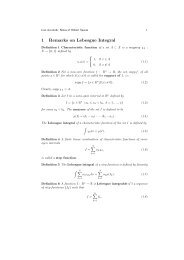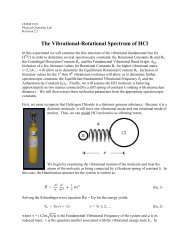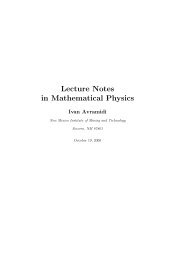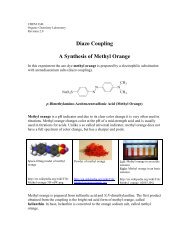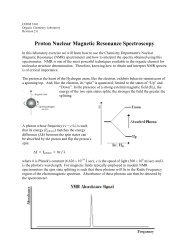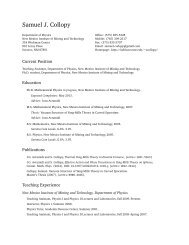– 18 –has been measured <strong>in</strong> the laboratory and agrees with a simple theory of conservation of angularmomentum and radial expansion of the plume (Beckley et al. 2003). All three effects are importantto the dynamo ga<strong>in</strong>. However, we will f<strong>in</strong>d that the dynamo ga<strong>in</strong> dur<strong>in</strong>g the life time of the accretiondisk, ∼ 10 8 years, is so large that the accuracy of the detailed description of these ”plumes” becomesof less importance compared to the facts of: (1) their axial displacement well above the disk; (2)their f<strong>in</strong>ite, ∼ π/2 radians, coherent rotation every star-disk collision; and (3) their subsidenceback to the disk <strong>in</strong> ∼ π radians. In this spirit we will estimate the hydrodynamics of the star-diskcollision, attempt<strong>in</strong>g to establish the universality of this phenomena as the basis of the accretiondisk dynamo. As far as we know no hydrodynamic simulations of the behavior of the disk matterdue to stars pass<strong>in</strong>g through the disk have yet been performed. (This is because of the difficulty of3-dimensional hydrodynamics with radiation flow.) The star passes through the disk at a velocity,close to the Keplerian velocity of the disk at whatever radius the collision happens. The soundspeed <strong>in</strong> the accretion disk is much less than the Keplerian speed v K : c s ≃ v K H/r ≃ 3 · 10 −3 v K atr ab , where H is the disk half-thickness given by expression (A5) <strong>in</strong> zone (a). Hence, the star-diskcollisions are highly supersonic. The temperature of the gas <strong>in</strong> the disk, shocked by the star mov<strong>in</strong>gat a Keplerian velocity, is of the order of the virial temperature <strong>in</strong> the gravitational potential ofthe central black hole. This pressure must <strong>in</strong>clude the radiation contribution, which <strong>in</strong> general, willbe much larger than the particle pressure. Because of the high Mach number of the collision, thepressure of the shocked gas is very much greater than the ambient pressure <strong>in</strong> the disk. This overpressure will cause a strong, primarily radial shock, radial from the axis of the trajectory, <strong>in</strong> thewake of the star, because of the large, length to diameter ratio of the hot channel, H/R ⊙ ≃ 4 · 10 2 .After the star emerges above the disk surface (i.e. higher than the half thickness of the disk), theheated shocked gas <strong>in</strong> the wake of the star cont<strong>in</strong>ues to expand sideways and furthermore starts toexpand vertically because of the rapidly decreas<strong>in</strong>g ambient pressure away from the disk mid-planewhere the pressure of the disk drops as ∝ exp(−z 2 /H 2 ). Thus this expansion can be treated asan adiabatic expansion <strong>in</strong>to vacuum after the plume rises by a few heights H above and below thedisk, provided the radiative loss is fractionally small. We would now like to estimate the size, orradius, r p , of the matter that rises ∼ 2H above the disk, or to a height l ≃ 3H above the mid-plane.Although smaller mass fractions with greater <strong>in</strong>ternal energy correspond<strong>in</strong>g to smaller radii of theshock will expand to greater heights above the disk, nevertheless we are concerned with only thismodest height, because we expect that the mass and hence entra<strong>in</strong>ed magnetic flux to be positivelycorrelated with plume mass, and we wish to maximize the entra<strong>in</strong>ed flux. On the other hand, byconservation of energy, a larger mass will rise or expand to a smaller height. We also desire theplume to rise sufficiently above the disk such that there is ample time for radial expansion andhence torqu<strong>in</strong>g of the entra<strong>in</strong>ed magnetic field dur<strong>in</strong>g the rise and fall of the plume material. Thiswill be our standard plume.The radial extend of the plume should be somewhat less than its vertical extend because thedensity gradient <strong>in</strong> the disk is largest <strong>in</strong> the vertical direction. The action of the Coriolis forceleads to an elliptical shape of the horizontal cross section of the plume. This is due to the fact thatepicycles of particles <strong>in</strong> the gravitational field of a po<strong>in</strong>t mass are ellipses with an axis ratio of 2
– 19 –and with an epicyclic frequency of Ω K . We performed simple ballistic calculations of trajectoriesof particles launched from a po<strong>in</strong>t at the mid-plane of the disk with <strong>in</strong>itial velocities <strong>in</strong> differentdirections <strong>in</strong> the horizontal plane. We obta<strong>in</strong>ed that at the time of maximum height of the plume,≈ T K /4, the position angle of the major axis of the ellipse is approximately −π/4 from the outwardradial direction e r . At the time of the fall back to the disk plane at ≈ T K /2, the major axis of theellipse is close to the azimuthal direction. Such a distortion <strong>in</strong> the shape of an otherwise cyl<strong>in</strong>dricalplume will only slightly affect the rotation of the entrapped toroidal flux and hence will not alterthe dynamo action.Before calculat<strong>in</strong>g the size or radius, r p , we first verify the adiabatic approximation <strong>in</strong> thatthe diffusion of radiation is fractionally small compared to the hydrodynamic displacements. Inthis circumstance of a Shakura–Sunyaev disk, this will allow us to treat the star-disk collisions asstrong shocks with<strong>in</strong> the disk matter. Subsequently we will consider the th<strong>in</strong>ner, lower densityRossby disks (Li et al. 2001b) where radiation transport will dom<strong>in</strong>ate over shock hydrodynamics.However, for the purposes of the dynamo, the production of helicity from either plumes will besimilar.4.1. Radiation Diffusion <strong>in</strong> the Collision ShockDur<strong>in</strong>g star-disk collisions the total energy taken from the star is ≈ ΣvK 2 πR2 ⊙ . This energyis distributed over a column of radial extent, ∆R rad , due to radiation transport. For an estimateof ∆R rad one can take the distance from the star track where the sideways diffusion of radiationbecomes comparable with the advection of the radiation by the displacement of the disk matterwith the star velocity v K (s<strong>in</strong>ce the velocity of strong shock is of the order of v K ). This results <strong>in</strong>∆R rad = c/3κρv K, (18)where for ρ we consider the density ahead of the shock <strong>in</strong> the undisturbed disk matter to comparethe radiation flux with the transport of energy and momentum by the shock. We assume κ =0.4cm 2 g −1 , Thompson opacity. Then us<strong>in</strong>g ρ from expression (A6) at r ab ,∆R rad = 10 8 cm = 1.4 · 10 −3 R ⊙ . (19)S<strong>in</strong>ce ∆R rad ≪ R ⊙ , the radiation will rema<strong>in</strong> local to the shocked fluid. The state conditions <strong>in</strong>this shocked matter will depend upon the rapid thermalization between the matter and radiation.The number of photon scatter<strong>in</strong>gs, n hν with<strong>in</strong> the time of traversal of the radiation front,∆R rad , becomes( )n hν = (∆R rad κρ) 2 c/3 2 ( ) r= = 50 . (20)v K r abTherefore the radiation will be fully absorbed and thermalized with the gas with<strong>in</strong> ∆R rad . S<strong>in</strong>cethe gas pressure is radiation dom<strong>in</strong>ated for r < r ab and the shock has a high Mach number,




